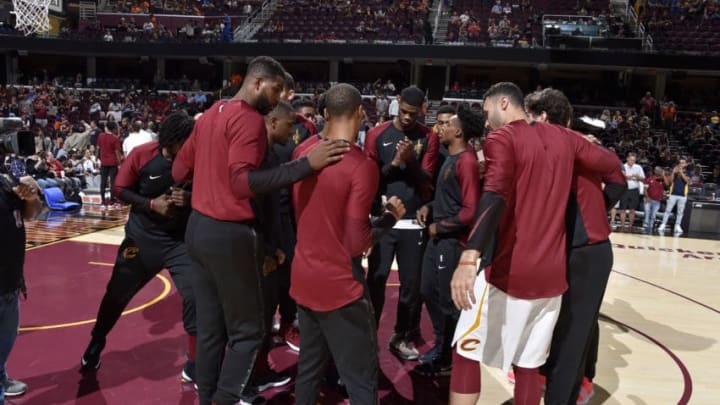The Cleveland Cavaliers lost their last preseason game to the Detroit Pistons Friday night 129-110, and that’s not a big deal, but they are going to need more assist totals in order to have sustained offense.
The Cleveland Cavaliers did not have Kevin Love, Cedi Osman or Larry Nance Jr. in their last preseason game against the Detroit Pistons. That was a obviously a massive difference in the game, as those three are all going to have huge roles. Love’s the first option, Osman is Cleveland’s best all-around wing, and Nance is a versatile defender and the Cavs’ most athletic big.
The Cavaliers still managed to score 110 points, which, on the surface, isn’t awful. Nonetheless, the offense for much of the preseason has not led to high assist totals, which is understandable, given a number of players in key roles and guys (like Love) sitting out in a precautionary manner not being on the floor.
Aside from Cleveland’s third preseason game against the Indiana Pacers, in which they had 27 assists, the Cavaliers have not had a great assist percentage. Cleveland has an assist percentage of 48.0 percent, which is the third-lowest among NBA squads in the NBA this preseason. Now, not having Love in there is a big reason for that.
However, the Cavaliers’ offense is going to be more focused on ball and man movement, and with Love’s passing ability out of the high-post, Cleveland should have more guys getting good open shots. A considerable amount of the Cavaliers do not present perimeter shooting threats this season, though, and as our own Jackson Flickinger noted after the loss to Indy, Cleveland will likely be very reliant on Kyle Korver‘s shooting.
As the season progresses, and players such as Sam Dekker, David Nwaba (who projects to be one of Cleveland’s most important defensive pieces), and Tristan Thompson potentially log significant minutes, the Cavs will need isolation players more.
Jordan Clarkson and Collin Sexton who are averaging 10.7 points on 48.1 percent shooting and 9.8 points per game on 41.2 percent shooting respectively, are going to need to carry the Cavs’ second unit. That’s all fine and dandy, considering they are two of Cleveland’s most talented perimeter players, but Clarkson is still prone to taking ill-advised shots (namely tightly contested long two’s) and Sexton is a rookie still gaining his footing.
When Thompson is playing the second unit 5 (which is going to be often), Cleveland is not going to have much second unit scoring or spacing with the lack of shooting on the perimeter. Clarkson and Sexton are gifted scorers that will be able to live in the mid-range pull-up area, but those in the long run are not efficient shots and Cleveland will need to rely on pushing the pace at virtually every opportunity.
Even in the first unit, the Cavaliers will need George Hill and Rodney Hood to be very efficient as scorers, and that’s a lot to ask, considering they won’t have the same amount of wide-open shots this season. Osman is the best passer on this roster, and although Hill did look good in the assist department at times in the preseason, he’s not going to realistically average more than 3.5 assists per game.
The Cavaliers can’t push the pace on every possession, so they’ll need to utilize a bunch of screens off the ball to get players easy looks. Contested long two’s by Hood and Hill aren’t sustainable offense, and with much more attention Love will get from defenses this year, it’s tough to see the Cavaliers just feed him constantly.
That could have some success in individual games, but Love could realistically get injured, and then the Cavs will have an even harder time getting open shots after drive-and-kicks.
Osman is going to get his this year, and with his tutelage from LeBron James, he’s gotten the passing thing down pretty well, but Cleveland needs players Nance, Dekker and Thompson to be alert passers. The Cavaliers can’t rely on early shot clock looks ALL the time.
I’m a huge proponent of them pushing the pace, but if occasionally they need to be more patient offensively to get a better look than a Thompson or Dekker jump shot, then they’ll have to do that. This team already appears to have more movement, and when shooters can go to the ball instead of wait for it, they generally are more in rhythm, as announcer and Cavs legend Austin Carr noted in yesterday’s broadcast.
For that to happen, though, sometimes you have to wait for plays to happen, and Sexton did a good job of that against Detroit. He had five assists, and should have had more. Patience in the offense, which doesn’t mean just standing around but relates to multiple actions, should in theory, lead to more assisted shots.
Moreover, 18.3 assists per game is fine, but if the Cavs only hit 9.0 three-point field goals (as they’ve done this preseason, per NBA.com), they won’t offset low assist totals. The Cavs need to find ways to get their good three-point shooters the ball in more comfortable spots, and get their cutters efficient shots near the rim.
Pull-up long two’s are decent ways to get guards in rhythm individually, but they aren’t great ways to score if you’re trying to return to the postseason.
Cleveland’s decrease in three-point attempt rate was alarming, per NBA.com’s John Schuhmann (h/t Fear The Sword’s Mike Zavagno).
Cleveland’s decrease in 3PAr (the largest in the league) is a real concern https://t.co/X8frRWEoN5
— Mike Zavagno (@MZavagno11) October 12, 2018
Hopefully Love and Sexton’s passing ability will open up more efficient shots, but the jury is still out on that long-term. If the Cavs end up trading Korver, Hill and/or J.R. Smith due to cap purposes, they’ll probably take even less threes.
Cleveland can’t just matchup-hunt all the time. That takes the role pieces out of rhythm. The lack of passing creativity on this team is something to monitor moving forward.
